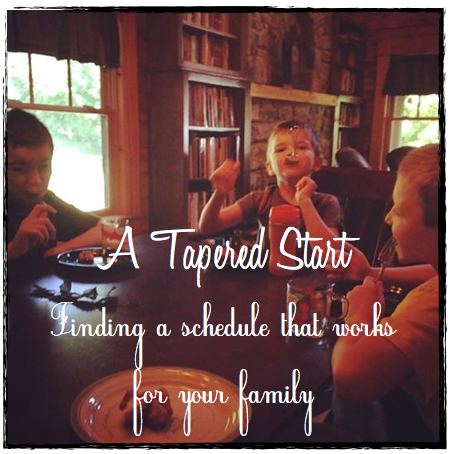
Things change. Routines shift. Schedules adjust. And you find yourself searching for a new normal.
When Gary was home a few weeks ago, I suddenly couldn’t breathe. “Gary, how in the world am I going to homeschool this year with an infant when you leave for Brazil?!?”
Nevermind the fact that we’ve homeschooled through a major move from Houston, TX to rural middle Tennessee where we knew no one. Or through the vibrations and reverberation of ear-splitting chainsaw noise as they built onto our home. Or through the recovery after a surgery on both of my eyes. Or through a pregnancy where I struggled to simply stay awake.
Nevermind the fact that I will be homeschooling next year with a toddler in tow.
One thing is certain: Nothing is certain.
(Stephen would point out that the above statement is illogical or that it’s some sort of whatchamacallit fallacy. That would be an upside to teaching your child logic. Another upside is that you start to pick apart your own writing.)
As Gary stepped up once again as Mr. Fixit, he offered his solution to my dilemma. “Just do a tapered start.”
A tapered start? What do you mean by a tapered start?
And so… a few weeks and a few discussions later, we started our school year. Monday marked our first day. With my dear husband almost 5,000 miles away from home. And an infant in my arms. We’re two days in, but I’m going to go ahead and say it. My husband was right. The tapered start works! As is the case with all our first-days-of-school, we continued our tradition of Monkey Bread for breakfast because some things do stay the same, thank goodness. For this first week, all we have completed is Bible and math.
That’s it.
Eventually, I’m hoping our schedule will look sort of like this:
Our Schedule (?)
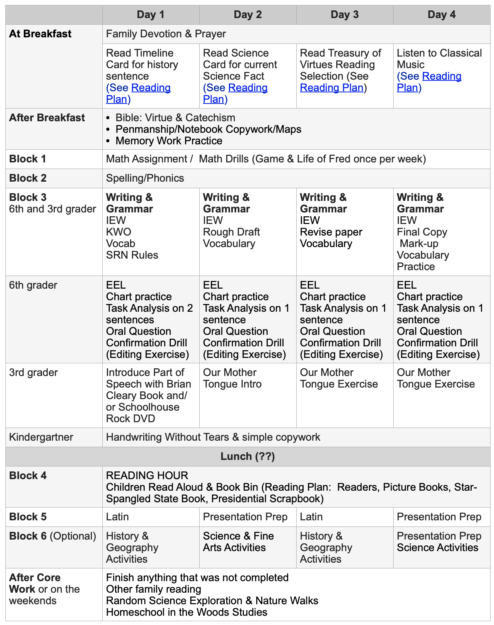
The Reading Plan referenced in the above table is here.
You might notice something about this schedule. It doesn’t have times. “Block” might mean an hour, or it might mean 20 minutes. Right now I have no idea how long it’s going to take to do anything. As “scheduled” as I have been in the past, I do not have Isaac on a feeding schedule. Even in the past without a baby, our schedule never followed my planned time slots. Our lives have had plenty of interruptions, and we just do our school work whenever and however it fits into our day.
{Also note that although it is not written on the schedule, we take breaks between blocks, and we sometimes take breaks within blocks. And the boys go outside and play and I cook (well, sometimes) and we clean up our messes (sort of)…}
Here’s the wonder of my husband’s brilliant idea: We can ease into our school year with less stress (because we took a break this summer due to obvious reasons), we can be more flexible and adjust our activities as needed, and I can discover how best to line out our day without overwhelming myself. We can find a schedule that works for us in the season we’re in.
Care to see what this year ended up looking like? Visit our post Plan vs. Reality: When You Spend All Year Tapering.
The Tapered Start
Yesterday, we started with just Bible and math and will continue to focus on that routine through Friday. Next week, we’ll add spelling and phonics/reading. The following week, we’ll add writing and English grammar. Then penmanship/copywork, mapmaking, and our reading plan will fall on the week we start our homeschool community days. Even so, we’re planning for flexibility even in our tapered start to the year. Why overwhelm ourselves starting out? There’s plenty of time to adjust to a new normal!
Running our homeschool on auto-pilot
Here are some other things we’re doing to equip our homeschool to run on auto-pilot…
1. The Book Bin. At the beginning of each week, I’m taking our reading plan and filling a basket full of the books that we’re planning to read that week. (This is why our reading plan was so detailed.)
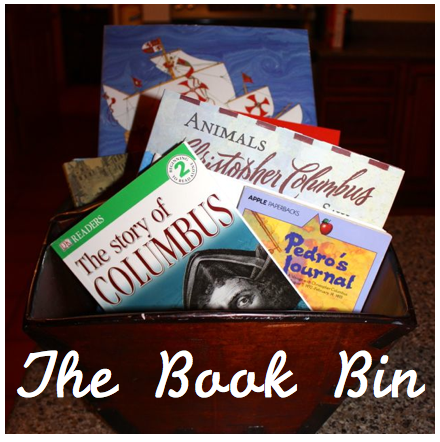
2. Checklists. I am nuts about checklists. I’ve found it helps us tremendously to stay on task. In fact, our planner was set up in a checklist format so that I can use it as my checklist throughout the day. (It has all three boys’ curriculum choices on each page.) Below is a screen shot of different ways in which our checklist-style planners might be used. By clicking on the image, you can download a copy to take a closer look. [You can download a variety of planners (including non-checklist type ones) on this planner post.]
The boys also have checklists in the front of their notebooks. We used something like this last year, and it worked well for us!
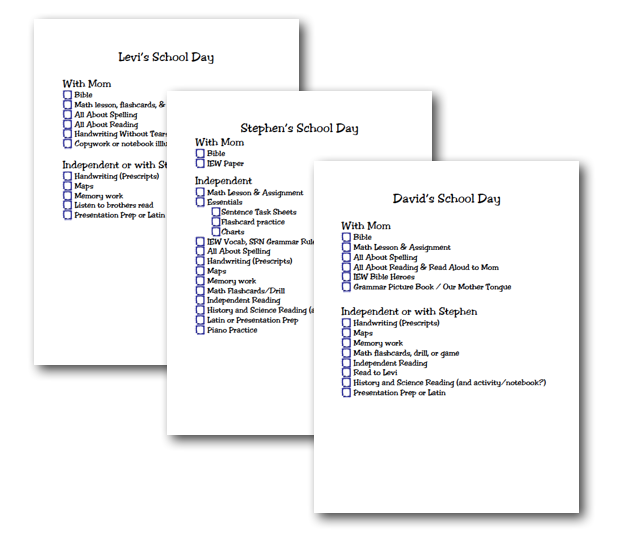
I’ve separated tasks that can be done without me from those that require my assistance so that they can continue to work through their daily work even if I am feeding the baby. [NOTE: Just because it is on this checklist does not mean it gets done. This is everything we might be doing over the course of a day, but… the reality is that we are juggling life with a baby in our midst. So… consider it more of a weekly checklist; over the course of a week, we have usually checked off everything on this list.]
3. Our Sixth Grader. Stephen is learning servant-leadership and responsibility this year as he helps his brothers with some of their daily schoolwork. His main goals are to help his younger brother David with Memory Master (since he has already been Memory Master for all three cycles, plus a triple-cycle memory master last year), to assist with the readings from our daily reading plans, to coordinate math and memory work review games to play as a family, and to lead the Song School Latin lessons. He is very excited about learning how to teach alongside me. I’m proud of him for stepping up to help our family this year.
Finally, for our own records I want to record our family’s curriculum choices for the coming year and mention a bit about notebooking. Our daily core work is:
- Reading
- Writing/Grammar
- Spelling
- Math
- Maps & Memory Work
Honestly, other things may fall by the wayside as they have a tendency to do. You can check back in 9 months to find out how far off we were when I write our annual Plan vs. Reality post.
2014-2015 Curriculum Choices
Core Subjects
- All Bible
- Family Devotional: Long Story Short: Ten-Minute Devotions to Draw Your Family to God
- We Choose Virtues Card-of-the-Week
- Grapevine Studies: Old Testament Catechism (First Semester)
- Grapevine Studies: New Testament Catechism (Second Semester)
- All Reading
- Our Reading Plan (plus additional independent reading)
- Acts & Facts History Cards (for copywork and reading)
- Acts & Facts Science Cards (for copywork and reading)
- All Memory Work and Making Connections
- Grade 6
- Math: Saxon 7/6
- Spelling/Phonics: All About Spelling Level 6 & 7
- English Grammar/Writing
- Essentials of the English Language
- IEW – U.S.-Based Writing Lessons
- Latin: Finish Latin’s Not So Tough Level 3
- Grade 3
- Math: Saxon 3
- Spelling/Phonics
- English Grammar/Writing
- Latin: Song School Latin 1 DVD
- Grade K
- Math: Saxon 1
- Spelling/Phonics
- All About Reading Level 1*
- All About Spelling Level 1* (after completion of AAR 1)
- English Grammar/Writing
- Finish Handwriting Without Tears K
- Practice sheets from www.printNpractice.com*
- Latin: Song School Latin 1 DVD
- {Refer to Reading Plan}
- Homeschool in the Woods Studies (at request of 6th grader):
Science
- Creation Science for Kids Human Anatomy e-book
- First Semester:
- Classic Elementary Life Science (free download)
- Lyrical Life Science (6th grader)
- Second Semester:
Read our review of We Choose Virtues here
Read about our past experiences with Homeschool in the Woods History Studies here
Notebooking & Memory Work Practice
Our family uses notebooking for memory work review, penmanship practice, and math-fact practice, as well as a means to record observations from nature and experiments. (You can download free notebook pages for all subjects here.) However, we are starting to move away from pre-printed copywork pages to using a sketch book or ruled notebook paper. It’s much easier, takes less effort and time for the parent to put together, and is more stick-in-the-sand than what we’ve done in the past. Plus, if they mess up, they just rip the page out and start on a new one. (I don’t have to reprint anything!)
Stephen uses a sketch book and David and Levi use primary journal books purchased from Wal-Mart. These are used primarily for science and history copywork.
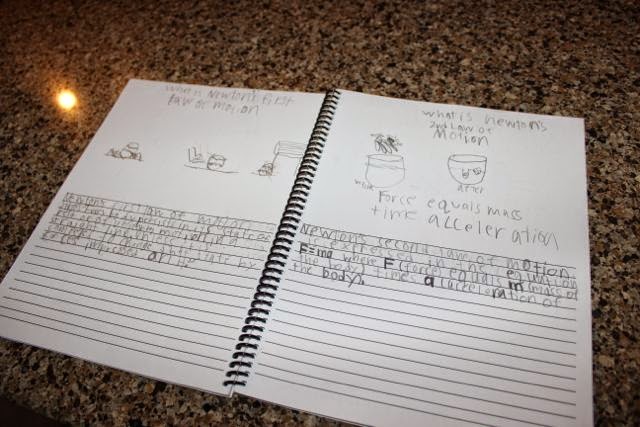
An Essentials Side Note. Stephen now uses a 3-subject spiral notebook of ruled paper for his Essentials work. One section is for his chart practice, another is for his sentence task analysis, and the third is for writing his IEW Key Word Outlines and rough drafts. (I did not feel like making a new Essentials student notebook this year – with all those extra copies of sentence task analysis sheets and everything – and he is happy to carry around less stuff on community days.)
The following is a list of notebooking activities to include in our notebooks.
- Geography – Trace or copy free-hand by referring to map
- Math – Drill Sheets from PrintnPractice.com; write multiplication facts on blank sheet of paper; Skip counting mazes or circle-and-write.
- Science – Lyrical Life Science. Use sketch book. Copy memory work and/or write about science topic or experiment in sketch book and draw illustration.
- History – Write memory work in sketch book and draw illustration.
- Timeline – Write timeline card title and draw illustration in timeline notebook.
- Latin & Bible – Copy Bible words or passage and Latin translation onto ruled paper or use our Latin notebook pages.
- English Grammar – Copy English grammar definitions onto ruled paper.
- Fine Arts -Use Fine Arts packet.
What our family does consistently: Maps, math fact practice, and copywork. We do not do all of the above notebooking activities consistently because of the writing we do in IEW (and we have boys with somewhat of an aversion to holding a pencil). We plan to make a better point of updating our Timeline notebook this year with events and people we come across in our reading.
Memory Work Practice: We occasionally play games, but we mostly have a spontaneous method of practicing, like when I am standing at the stove and simply state a memory work prompt (or hum a history sentence tune). Memory work practice can be quite simple! Our family is proof of that!
Whelp, I’ve pretty much used up the minimal amount of time I’ve had to write a post! Here’s hoping all of you have a successful start to your school year as well!

